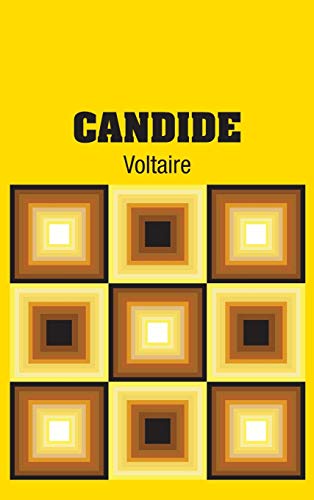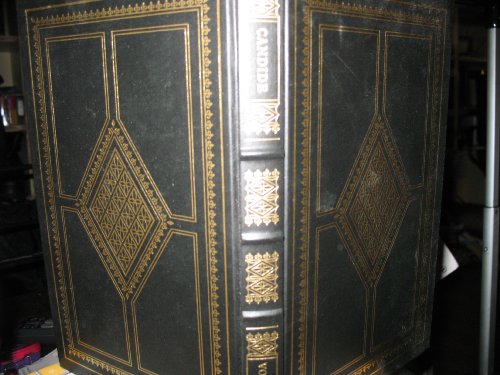-
Candide
Voltaire
eBookThis book was converted from its physical edition to the digital format by a community of volunteers. You may find it for free on the web. Purchase of the Kindle edition includes wireless delivery.
-
Candide
Voltaire
Paperback (Independently published, Aug. 3, 2019)A new, beautifully laid-out, easy-to-read edition of Voltaire's Candide. Candide is Voltaire's 1759 satirical masterpiece, wreaking havoc on the excesses of 18th century French Enlightenment culture. The story begins with our protagonist Candide, a young man living a sheltered life in an Edenic paradise and being indoctrinated with Leibnizian optimism by his mentor, Professor Pangloss. This idyllic life is abruptly interrupted, however, by a series of painfully disillusioning events that set him off on a wide-ranging journey.François-Marie Arouet (1694-1778), known by his nom de plume Voltaire, was a French enlightenment writer, historian, and philosopher famous for his wit and his advocacy for freedom of speech and religion.
-
Candide
Voltaire
Paperback (CreateSpace Independent Publishing Platform, Nov. 1, 2018)Candide is a French satire first published in 1759 by Voltaire, a philosopher of the Age of Enlightenment. The novella has been widely translated, with English versions titled Candide: or, All for the Best (1759); Candide: or, The Optimist (1762); and Candide: or, Optimism (1947). It begins with a young man, Candide, who is living a sheltered life in an Edenic paradise and being indoctrinated with Leibnizian optimism (or simply "optimism") by his mentor, Professor Pangloss. The work describes the abrupt cessation of this lifestyle, followed by Candide's slow, painful disillusionment as he witnesses and experiences great hardships in the world. Voltaire concludes with Candide, if not rejecting optimism outright, advocating a deeply practical precept, "we must cultivate our garden", in lieu of the Leibnizian mantra of Pangloss, "all is for the best" in the "best of all possible worlds".Candide is characterised by its sarcastic tone as well as by its erratic, fantastical and fast-moving plot. A picaresque novel with a story similar to that of a more serious bildungsroman, it parodies many adventure and romance clichés, the struggles of which are caricatured in a tone that is mordantly matter-of-fact. Still, the events discussed are often based on historical happenings, such as the Seven Years' War and the 1755 Lisbon earthquake. As philosophers of Voltaire's day contended with the problem of evil, so too does Candide in this short novel, albeit more directly and humorously. Voltaire ridicules religion, theologians, governments, armies, philosophies, and philosophers through allegory; most conspicuously, he assaults Leibniz and his optimism.As expected by Voltaire, Candide has enjoyed both great success and great scandal. Immediately after its secretive publication, the book was widely banned because it contained religious blasphemy, political sedition and intellectual hostility hidden under a thin veil of naïveté. However, with its sharp wit and insightful portrayal of the human condition, the novel has since inspired many later authors and artists to mimic and adapt it. Today, Candide is recognized as Voltaire's magnum opus and is often listed as part of the Western canon; it is arguably taught more than any other work of French literature. Martin Seymour-Smith has listed Candide as one of The 100 Most Influential Books Ever Written.
-
The Fourth Book of Virgil's Aeneid and the Ninth Book of Voltaire's Henriad
Virgil, Voltaire
eBookThis book was converted from its physical edition to the digital format by a community of volunteers. You may find it for free on the web. Purchase of the Kindle edition includes wireless delivery.
-
Candide
Voltaire
Hardcover (Chump Change, April 21, 2017)Unabridged English version of Candide by Voltaire, offered here for chump change. A book for those desiring to contemplate life, Voltaire subtly challenges the reader’s complacent view of the world through extreme, and often gruesome, exaggeration.Written in 1759, it tells the story of Candide, who gets kicked out of the castle, forced to serve on a boat, shipwrecked, robbed, tortured, and on and on, without losing his desire to continue forward in life.ContentsI: HOW CANDIDE WAS BROUGHT UP IN A MAGNIFICENT CASTLE, AND HOW HE WAS EXPELLED THENCE. 3II: WHAT BECAME OF CANDIDE AMONG THE BULGARIANS. 3III: HOW CANDIDE MADE HIS ESCAPE FROM THE BULGARIANS, AND WHAT AFTERWARDS BECAME OF HIM. 5IV: HOW CANDIDE FOUND HIS OLD MASTER PANGLOSS, AND WHAT HAPPENED TO THEM. 6V: TEMPEST, SHIPWRECK, EARTHQUAKE, AND WHAT BECAME OF DOCTOR PANGLOSS, CANDIDE, AND JAMES THE ANABAPTIST. 7VI: HOW THE PORTUGUESE MADE A BEAUTIFUL AUTO-DA-FÉ, TO PREVENT ANY FURTHER EARTHQUAKES; AND HOW CANDIDE WAS PUBLICLY WHIPPED. 8VII: HOW THE OLD WOMAN TOOK CARE OF CANDIDE, AND HOW HE FOUND THE OBJECT HE LOVED. 9VIII: THE HISTORY OF CUNEGONDE. 10IX: WHAT BECAME OF CUNEGONDE, CANDIDE, THE GRAND INQUISITOR, AND THE JEW. 11X: IN WHAT DISTRESS CANDIDE, CUNEGONDE, AND THE OLD WOMAN ARRIVED AT CADIZ; AND OF THEIR EMBARKATION. 12XI: HISTORY OF THE OLD WOMAN. 13XII: THE ADVENTURES OF THE OLD WOMAN CONTINUED. 14XIII: HOW CANDIDE WAS FORCED AWAY FROM HIS FAIR CUNEGONDE AND THE OLD WOMAN. 16XIV: HOW CANDIDE AND CACAMBO WERE RECEIVED BY THE JESUITS OF PARAGUAY. 17XV: HOW CANDIDE KILLED THE BROTHER OF HIS DEAR CUNEGONDE. 18XVI: ADVENTURES OF THE TWO TRAVELLERS, WITH TWO GIRLS, TWO MONKEYS, AND THE SAVAGES CALLED OREILLONS. 19XVII: ARRIVAL OF CANDIDE AND HIS VALET AT EL DORADO, AND WHAT THEY SAW THERE. 21XVIII: WHAT THEY SAW IN THE COUNTRY OF EL DORADO. 22XIX: WHAT HAPPENED TO THEM AT SURINAM AND HOW CANDIDE GOT ACQUAINTED WITH MARTIN. 25And More! All 30 Chapters.
-
Candide
Voltaire
Hardcover (Simon & Brown, Oct. 18, 2016)None
-
Micromegas
Voltaire
Paperback (CreateSpace Independent Publishing Platform, May 4, 2016)The story is organized into seven brief chapters. The first describes Micromégas (small/large), an inhabitant of one of the planets that orbits Sirius. His home world is 21.6 million times greater in circumference than the Earth. Micromégas stands 120,000 feet (about 23 miles) tall. When he is almost 450 years old, approaching the end of his infancy, Micromégas writes a scientific book examining the insects on his planet, which at 100 feet are too small to be detected by ordinary microscopes. This book is considered heresy, and after a 200-year trial, he is banished from the court for a term of 800 years. Micromégas takes this as an incentive to travel around the Universe in a quest to develop his intellect and his spirit. After extensive celestial travels he arrives on Saturn, where he befriends the secretary of the Academy of Saturn, a man less than a twentieth of his size (a "dwarf" standing only 6,000 feet tall). They discuss the differences between their planets. The Saturnian has 72 senses while the Sirian has 1,000. The Saturnian lives for 15,000 Earth years while the Sirian lives for 10.5 million years; Micromégas reports that he has visited worlds where people live much longer than this, but still consider their lifespans too short. At the end of their conversation, they decide to take a philosophical journey together. Eventually, they arrive on Earth and circumnavigate it in 36 hours, with the Saturnian only getting his lower legs wet in the deepest ocean and the Sirian barely wetting his ankles. They decide that the planet must be devoid of life, since it is too small for them to see with the naked eye. In the Baltic Sea, the Saturnian happens to spot a tiny speck swimming about, and he picks it up to discover that it is a whale. As they examine it, a boatful of philosophers returning from an Arctic voyage happens to run aground nearby. The space travellers examine the boat and, upon discovering the lifeforms inside it, they conclude that the tiny beings are too small to be of any intelligence or spirit. Yet they gradually realize the beings are speaking to each other, and they devise a hearing tube with the clippings of their fingernails in order to hear the tiny voices. After listening for a while, they learn the human language and begin a conversation, wherein they are shocked to discover the breadth of the human intellect. The final chapter sees the humans testing the philosophies of Aristotle, Descartes, Malebranche, Leibniz and Locke against the travellers' wisdom. When the travellers hear the theory of Aquinas that the universe was made uniquely for mankind, they fall into an enormous fit of laughter. Taking pity on the humans, the Sirian decides to write them a book that will explain the point of everything to them. When the volume is presented to the Academy of Science in Paris, the secretary opens the book only to find blank pages.
-
Candide
Voltaire
Paperback (Chump Change, April 22, 2017)Unabridged English version of Candide by Voltaire, offered here for chump change. A book for those desiring to contemplate life, Voltaire subtly challenges the reader’s complacent view of the world through extreme, and often gruesome, exaggeration.Written in 1759, it tells the story of Candide, who gets kicked out of the castle, forced to serve on a boat, shipwrecked, robbed, tortured, and on and on, without losing his desire to continue forward in life.ContentsI: HOW CANDIDE WAS BROUGHT UP IN A MAGNIFICENT CASTLE, AND HOW HE WAS EXPELLED THENCE. 3II: WHAT BECAME OF CANDIDE AMONG THE BULGARIANS. 3III: HOW CANDIDE MADE HIS ESCAPE FROM THE BULGARIANS, AND WHAT AFTERWARDS BECAME OF HIM. 5IV: HOW CANDIDE FOUND HIS OLD MASTER PANGLOSS, AND WHAT HAPPENED TO THEM. 6V: TEMPEST, SHIPWRECK, EARTHQUAKE, AND WHAT BECAME OF DOCTOR PANGLOSS, CANDIDE, AND JAMES THE ANABAPTIST. 7VI: HOW THE PORTUGUESE MADE A BEAUTIFUL AUTO-DA-FÉ, TO PREVENT ANY FURTHER EARTHQUAKES; AND HOW CANDIDE WAS PUBLICLY WHIPPED. 8VII: HOW THE OLD WOMAN TOOK CARE OF CANDIDE, AND HOW HE FOUND THE OBJECT HE LOVED. 9VIII: THE HISTORY OF CUNEGONDE. 10IX: WHAT BECAME OF CUNEGONDE, CANDIDE, THE GRAND INQUISITOR, AND THE JEW. 11X: IN WHAT DISTRESS CANDIDE, CUNEGONDE, AND THE OLD WOMAN ARRIVED AT CADIZ; AND OF THEIR EMBARKATION. 12XI: HISTORY OF THE OLD WOMAN. 13And More! All 30 Chapters!
-
Candide, Zadig and Selected Stories
Voltaire
Paperback (SIGNET CLASSICS, Jan. 1, 2009)Candide, Zadig and Selected Stories by Voltaire, Francois [Signet Classics, 2009] ( Paperback ) [Paperback ]
-
Candide
Voltaire
Hardcover (Simon & Brown, Oct. 15, 2018)None
-
Candide, Zadig and Selected Stories
Voltaire
Paperback (SIGNET CLASSICS, Jan. 1, 2009)Candide, Zadig and Selected Stories by Voltaire, Francois [Signet Classics, 2009] ( Paperback ) [Paperback ]
-
Candide
VOLTAIRE
Leather Bound (FRANKLIN LIBRARY, March 15, 1983)From review - "Candide, ou l'Optimisme is a French satire first published in 1759 by Voltaire, a philosopher of the Age of Enlightenment."